A Song of Waking and Mirrors
Doctor Who: The Rings of Akhaten
spoilers through the episode.
meta: Myth, Chairs, Mirrors, Rings vs. Leaves
Special Guest Star: Ouroboros
[Open Your Eyes]------------------------------------------------------------------------------
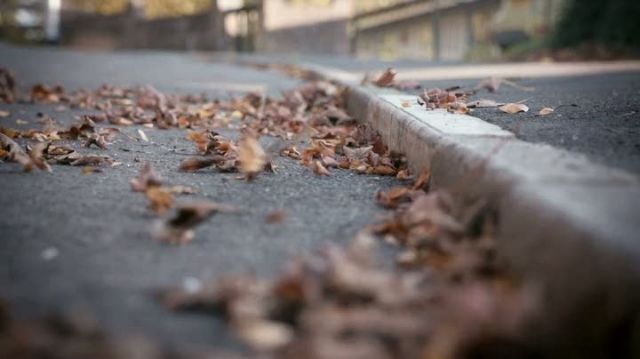


The opening shot. Leaves on the ground, all dead. The next shot has more dead leaves, and the third, blowing on the wind. Now, as a director, if you're devoting your first three shots to dead leaves, you better have a good reason. It's got to be important symbolically, thematically, something that will pay off in the climax of the story.
Here's the fourth shot:
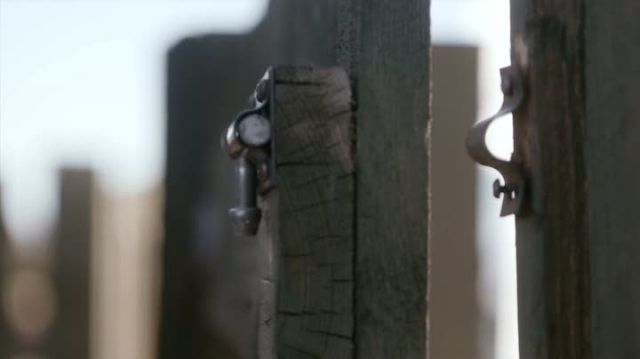
A wood door. The strip of metal on the frame forms a visual ring. The door shuts, blocking out the light, effectively closing the loop. This is a metaphor, and it sums up the entire climax of the story. It's a story of a Tree defeating a Ring. Pretty clever, eh?
With that in mind, we can begin.
First, these are all images of death. Subtle, yes, but death isn't always grandiose, full of pomp and circumstance. Sometimes death comes as a whisper on the wind, a stillness in the heart, or a leaf in the face. Dave Oswald receives the latter, stumbles out into the street, and is about to die when he's saved by Ellie Ravenwood. Dave gets a new lease on life, and he makes the most of it.
He takes the singular leaf and from it he fashions a story of Love.
DAVE: This exact leaf
had to grow in that exact way, in that exact place,
so that precise wind could tear it from that precise branch
and make it fly into this exact face, at that exact moment,
and if just one of the tiny little things had never happened
I'd never have met you.


So, a bit on names. "Oswald" is often taken to mean "God's power." But another etymology lurks beneath the surface: "wald" means forest in German. David, on the other hand, comes from the Hebrew, "beloved." Also there's only one David in Christian bible, but he's referenced over a thousand times, most famously for slaying Goliath and becoming King of Israel.
Ellie, popularly thought to mean "light," derives from Eleanor, which has many variations -- including Leonora and Lenore, the latter most well known through Edgar Allen Poe's poems. "Lenore" is about the the death of a young woman, but rendered in uplifting verse:
"Avaunt! - to-night
My heart is light -
No dirge will I upraise,
But waft the angel on her flight
With a Pæan of old days!
Let no bell toll!
Lest her sweet soul,
Amid its hallow'd mirth,
Should catch the note
As it doth float
Up from the damned earth -
To friends above, from fiends below, th' indignant ghost is riven -
From grief and moan
To a gold throne
Beside the King of Heaven?"
But of course everyone's much more familiar with The Raven. Poe's raven comes tapping and rapping on the door, a messenger of mournful and never-ending Remembrance -- which is much in line with the Raven's mythological connotations, be it the bird spurned by Apollo for delivering news of unfaithfulness, or Odin's twin ravens of thought and memory.
Once upon a midnight dreary, while I pondered, weak and weary,
Over many a quaint and curious volume of forgotten lore -
While I nodded, nearly napping, suddenly there came a tapping,
As of some one gently rapping, rapping at my chamber door.
"'Tis some visiter," I muttered, "tapping at my chamber door -
Only this and nothing more."
Ah, distinctly I remember it was in the bleak December;
And each separate dying ember wrought its ghost upon the floor.
Eagerly I wished the morrow; - vainly I had sought to borrow
From my books surcease of sorrow - sorrow for the lost Lenore -
For the rare and radiant maiden whom the angels name Lenore -
Nameless here for evermore.
Funny how Ellie's last name is Ravenwood, drawing on the mythic bird implied by her name, set in the forest shared in common with the name of her betrothed.
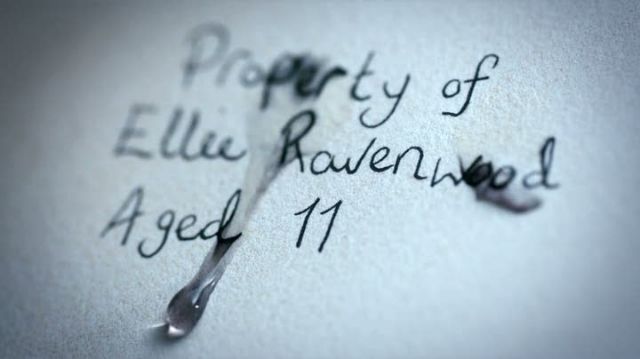
When Ellie dies, and book of 101 Places to See falls to her daughter. And with it, the Leaf that brought all these events into being. It's not an ordinary leaf, by any means. This is an alchemical leaf. It is a Leaf that represents both Love and Death.
If that sounds familiar, it should. It's the main thrust of The Wedding of River Song.
In the Wedding, River doesn't want to kill the Doctor, and the Doctor doesn't want to marry River. She doesn't want to lose him, and he doesn't want to accede to love and the pain that inevitably comes of it. And yet to resolve the problem of all of time happening at once, both of them must give in. The Doctor must love, and the Doctor must die.
These two things happen in two different places, yet simultaneously. They occur at a Lake, and at a Pyramid (where Eldritch terrors are encased in Glass.) The funny thing is that when when the Doctor and Clara wake up the Grandfather God after defeating the mummy at the Pyramid of Akhaten, they discuss running away to "the Lake District."

Sorry, I'm getting ahead of myself.
The World Tree is that which connects Above and Below and Past and Future into the Here and Now. It is the axis mundi which binds together the opposite ends of polarities. It is the line between birth and death. It is not, importantly, a Ring.
Now, there are all kinds of trees in the world, all kinds of leaves. And strangely enough, the Leaf we see in The Rings is not quite the same as the Leaf we see in The Bells. It's like a Maple Leaf (which is sweetness, hello!) turns into a Linden Leaf. And the Linden Tree has an interesting presence in Myth and Literature.
It is a tea made from Linden Leaves that the narrator of Proust's In Search of Lost Time dips his petite madeleine, triggering the wash of Memory that is subsequently explored throughout that seminal work. Yes, "Lost Time."
Yesteryear's poems often equated the Linden Leaf with Love, because the leaf is shaped like a Heart. How perfect is it that Clara's Leaf just happens to be Red?
The ancient Germans held community festivals under a Linden Tree, but also judicial proceedings -- it was believed the tree could unearth the truth. The Greek myth of Baucis and Philemon has them blessed by the gods at their death, becoming an oak tree and linden tree, respectively, intertwined and overlooking an ornate temple in the middle of a lake -- a lake formed by a flood in punishment towards the otherwise inhospitable inhabitants; only Baucis and Philemon shared their wine and food with the disguised gods of Zeus and Hermes.
Of most interest to me is the story of Siegfried in the Nibelungenlied, the basis for Wagner's Ring Cycle. In this ancient myth, the crown prince of Xanten who slayed a dragon. By bathing in the blood of the dragon, Siegfried became completely invulnerable -- except for a single spot on his back, where a Linden Leaf had stuck.
With that in mind, let's turn to the other primary symbol in this episode:
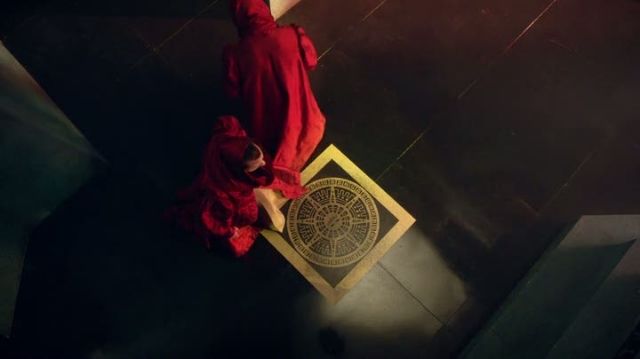


This is a recurring motif in the current era. It is the conjunction of Square and Circle, and it is an alchemical referent. "Squaring the Circle" is a mathematical impossibility, but symbolically the Circle in the Square stands for the union of opposites, the basic principle of alchemy. Finding Eeternity in the Now. It's also a motif of Order, so geometrical, so... perfect.
All those heads in boxes, from A Good Man to Dorium's head in the Wedding, to the heads in boxes of The Great Intelligence's cloud, play on this motif. It's even punned -- inventing the QuadriCycle.
But the single best representation of it has to come from The Doctor's Wife:
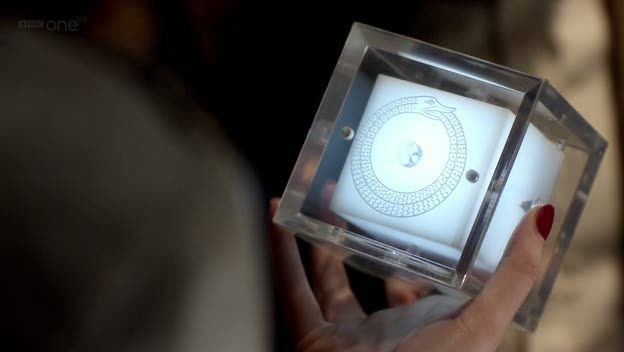
The Snake (or Wurm, or Dragon) eating its own tail, encased in glass, the mark of the Corsair, who is a Pirate -- a parasite -- is the symbol of Ouroboros, an ancient symbol of the cycle of life. The symbol first appears in the historical record in Egypt, in the tomb of Tutankhamun. The New Adventures -- Doctor Who books from the early 90's -- played with the symbol in the Timewrym quartet. Plato describes the Ouroboros as the first living thing in the Universe.
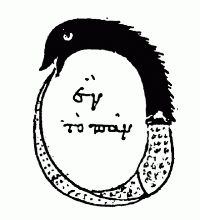
The Snake is the Alpha and Omega, the beginning and the end, death and rebirth; it also symbolizes the One and the All -- affirming that the individual and the Universe are One. It is Communion. The alchemist Cleopatra of Egypt -- not to be confused with the eponymous queen -- drew the Ouroboros as a fusion of light and dark, of opposites.
Here's the thing about Ouroboros: Life feeds on Life. It is a symbol of Eating, of Consumption, for Eternity. And it's in this symbol that the "god" Akhaten feeds on the neverending Song given over and over again by the people of the Seven Worlds.
On the Nature of Being Lost
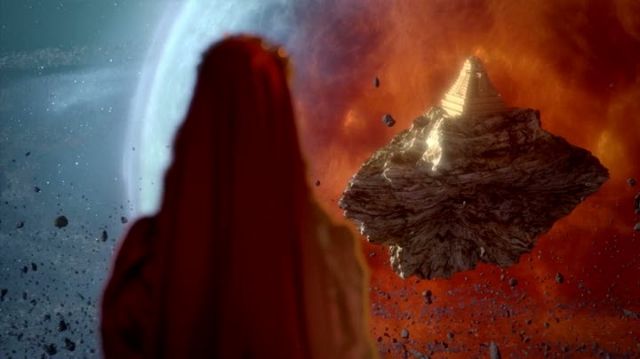
Another visual allusion to the alchemical principle of fusion -- the union of opposites -- in Doctor Who is the juxtaposition of Red and Blue. It's been with us since Rose (or Paradise Towers for you Classic fans.) We code Red and heat, passion, flame and fire, the sun, light; Blue is cool, water, ice, the moon, night.
Akhaten is already infused with Alchemy. It is a place beyond the confines of dualism. We see a Pyramid, a place of Death that's supposed to be a place of Rebirth, sitting upon an Island in space.
Yes, an Island.
But we don't see this principle just in places. It's very often coded in people and their possessions. Melody's Red Corvette skidding to a halt next to the Doctor's Blue Box. Rory's favorite car parked outside the blue door of Amy's new home. Especially in Moffat's era, it's a regular part of our Companion's outfits, like Amelia Pond sitting in the garden, waiting for the Doctor in her blue duffel coat and red wellies.
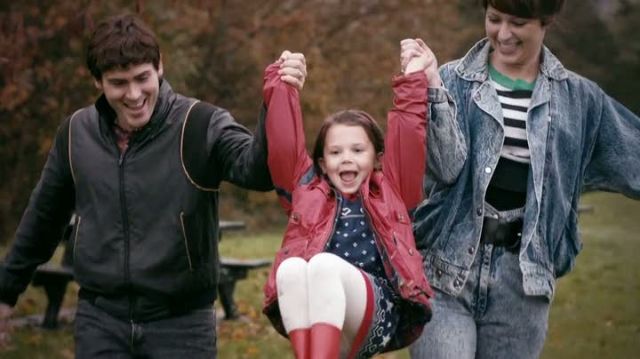

Clara continues this trend. She wears Red and Blue as a child, swinging between her parents. She matches a red purse with her blue dress. When she needs a place to hide a Little Girl wearing a red cloak, behind the blue box is just about perfect.
The Little Girl, by the way, is called The Queen of Years. She is a Child of Time. But she's also a Child of Story -- she knows every poem, every song, the entire history of her people.
It's behind the blue box -- which has that lovely St John Ambulance symbol on the front, another Circle in a Square -- that Clara shares the tale with Merry of how she got Lost. ("Lost" is a word repeated ten times in this story. I think it might be important.)
CLARA:
I used to be terrified of getting lost.
Used to have nightmares about it.
And then... I got lost.
Blackpool beach, bank holiday Monday.
About ten billion people;I was about six.
My worst nightmare come true.
Now, this is an interesting story, because it sounds... familiar. Very familiar to the story told by another little girl who got Lost. A little girl who wore Red Wellies. Ringing any bells?


JENNIFER:
When I was a little girl, I got lost on the moors.
Wandered off from the picnic.
I can still feel how sore my toes got
inside my Red Wellie boots.
And I imagined another little girl, just like me,
in Red Wellies, and she was Jennifer, too.
Except she was a strong Jennifer, a tough Jennifer.
She'd lead me home.
The Rebel Flesh took place on an Island where they mined Acid -- which, in addition to being an industrial solvent, is also a hallucinogenic drug that can change people's lives. By the end of this story, Jen becomes a Monster, and Amy Pond gets juxtaposed with her, Revealed as being of The Flesh, and is then melted by the Doctor, only to Wake Up in a small box, all white, like a coffin, ready to give birth to a Song. A horrifying vision of Ascension.
(Interestingly, the book referenced in last week's episode, Summer Falls by Amelia Williams, invokes some of the imagery from that story. A little girl, Kate Webster, gets caught in a "snow globe" that makes it such that her new little village is like an Island separated from the rest of the world. There's a Weather Vane that's part of the resolution to the story. Anyways, I digress, mostly to make the point that The Island in the TV show "LOST" is described as being "stuck in a bloody snowglobe," an image that recurs in Fringe, which features Red and Blue universes that may be crossed via... you guessed it, an Island. Ellis Island.)
Meanwhile, in Doctor Who, Clara is telling Mary a story:
MERRY:
What happened?
CLARA:
The world ended. My heart broke.
And then my Mum found me.
We had fish and chips
and she drove me home
and she tucked me up
and she told me a story.
So, a couple things here. First, how apocalyptic it is to be lost! The end of the world, and a broken heart... and then salvation. Mom comes, and there's a communion of fish and chips. Rose and the Doctor typically communed over Chips, while Eleven's food of communion is definitely Fish, preferrably dipped in custard.
Lots and lots of Fish in Moffat's work. It's also symbolic -- think the Icthys of Christendom. Communion, all I'm saying. Anyways, we now get a FlashBack to the story Clara's mum tells Clara, which presumably Clara then tells Merry:
ELLIE:
It doesn't matter where you are --
in the jungle or the desert or on the moon.
However lost you may feel,
you'll never really be lost. Not really.
Because I'll always be here.
And I'll always come and find you.
Every single time.
And this is rather important to the overall story, because now Clara's telling the Little Girl-Queen of Stories a story, in such a way that Clara is to Merry as Ellie is to Clara. There's a level of Mirroring going on here between the two, an establishment of juxtaposition that allows us to draw parallels between these two characters -- in particular, it gives us a metaphor for Clara, who is the great "unknown" in this long tale. It also establishes foreshadowing: Clara, as her mother, goes after the Little Girl... and Ellie, being Clara's mum, does indeed "find" Clara in the end.
Here's another way that Clara and Merry are juxtaposed:
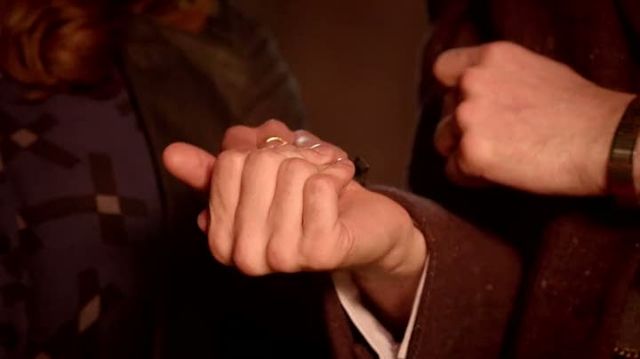
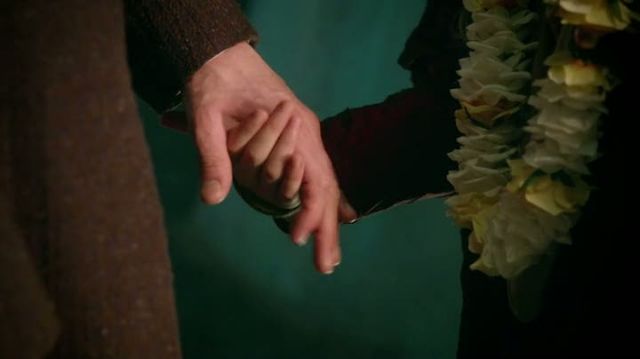
The takes Clara's hand when they first get to Akhaten. Later, he takes Merry's hand. Now, this is a trope of the new series. Nine was always taking Rose's hand and leading her away from danger, a chance to go and run; so too with Ten and his companions, including River; so too with Eleven and Amy, upon their first meeting.
It's lampshaded in The Snowmen, when Clara takes the Doctor's hand and leads him away from the Ice Governess, reversing their roles as he protests.
The Doctor has made Merry like a "companion" by taking her hand, which makes her like Clara.
But that's not the only hand-taking that occurs in this episode. When Clara first meets Merry, and wins her trust by recognizing that the girl is distressed (or "lost") she takes her by the hand and leads her to the TARDIS. And the TARDIS won't let her in. Clara wonders if the TARDIS doesn't like her.
I'm not sure that's quite it. Look at this:
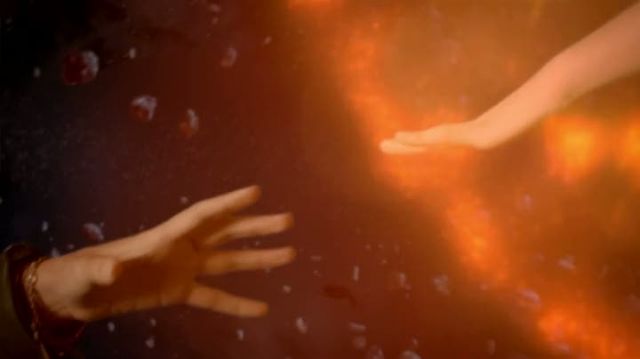
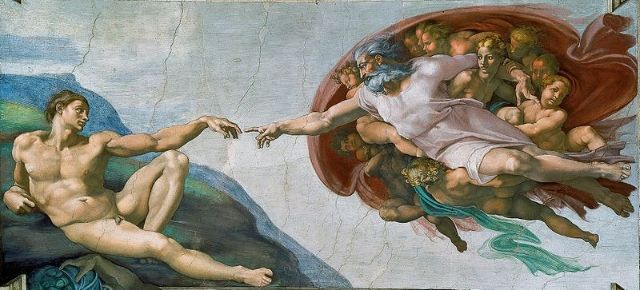
Clara is behaving "Doctorish" by taking Merry by the hand, but Clara's not ready to be Doctorish yet. Merry's the one who's full of stories and songs, and more importantly, she's will to make sacrifice: she's closer to divinity than Clara, a suggested by the iconography.
Or maybe it's that the TARDIS recognizes that it's not time to hide, but to connect, to share stories, to allay fear and exchange hugs. To be found.
Regardless, Clara and the Little Girl are mirrored. But she's not the only mirror for Clara:
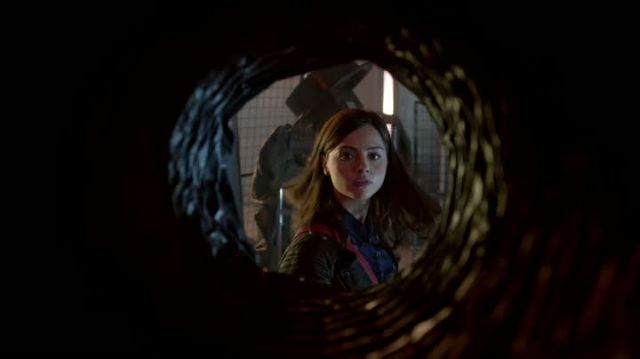
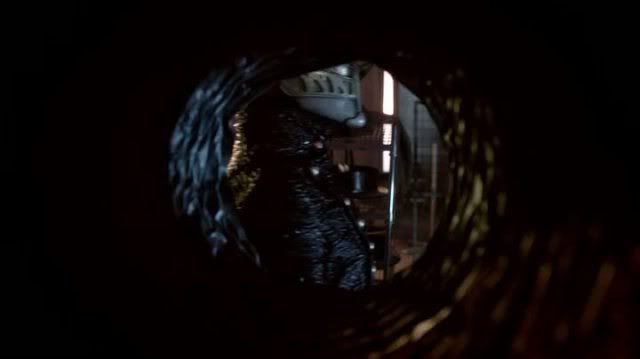
So many recurring motifs! On the left is a shot of Clara just as she's getting involved with the Little Red Riding Hood. The shot is made from inside a large silvery tube -- silver is the color of Mirrors, of reflections -- and it's as if Clara is about ready to fall down The Rabbit Hole.
It's the first way that Alice in Wonderland "gets lost" -- the second time, she passes Through The Looking Glass.
It's a shot that's very similar to a shot from Closing Time. The Doctor crawls down a narrow tunnel to the Cybership -- a tunnel he finds behind a Mirror.
But the shot on the right has a second purpose, which is to juxtapose Clara. On the right, from the same angle, we see The Vigil. Thematically speaking, we should see Clara taking on the role of The Vigil somewhere in the story.
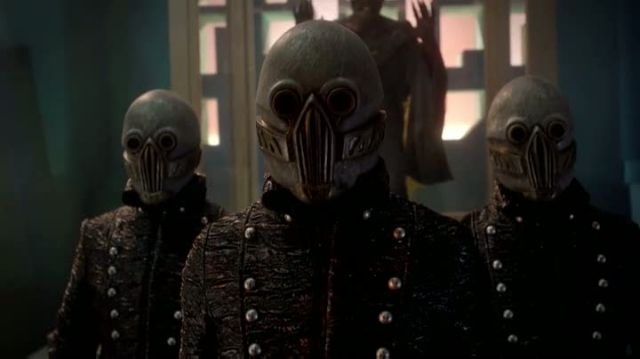
The Vigil: Interesting name for what amounts to a bunch of henchmen.
A "vigil" is ritual of wakefulnesss, of paying attention, staying alert, focused, concentrated. Liturgical vigils often incorporate periods of silence and meditation with chants, prayers, and readings. Some vigils can last all night, as did the vigils of medieval knights before their initiations.
If there's somebody up there could they throw me down a line
just a little guiding light to tell wrong from right
just some answers to the questions that I'm asking you
I'll keep a vigil in a wilderness of mirrors
where nothing here is ever what it seems
I'm scared to shout in case I draw attention from the powers
that preside over our minds and our lives
when they find what I want is the deadliest weapon,
that is truth
"Vigil (in a Wilderness of Mirrors)" -- Fish
In modern times we often use the Candlelight Vigil as a ritual of remembrance. Interestingly, the first Vigiles were ancient Romans charged with putting out fires -- professional firefighters. Because they patrolled at night as well as day, they became Watchmen, on the lookout for burglars and other criminals. So firefighters doubled down as Policeman. Huh.

In this story, The Vigil are charged with making sure the Queen of Years will take her place as sacrifice; they are a combination of "watchmen" and religious authority. Clara fulfills their function when she leads Merry back to the other Choristers, foreshadowed by the TARDIS (where Clara first leads Merry) being behind bars.
Police Box, indeed.
The Nature of Alchemy
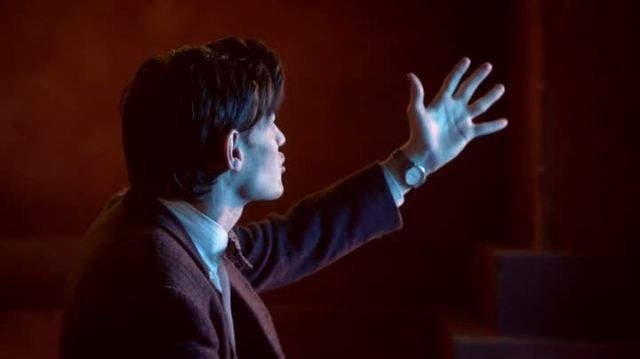
Red Background + Blue Doctor = Purple Clothes
The other character juxtaposition of note has to do with the Doctor. The Doctor brings Clara to a place he's been before -- a place he's taken his Granddaughter. Now, fans of the Classic series will remember that when we first meet the Doctor, who in his first incarnation is a cantankerous old man, he's traveling with Susan, his granddaughter who always calls him "Grandfather" rather than "The Doctor."
The Doctor is the Mad Man in a Box. Guess who else we get "in a box" this episode? A "god" who is referred to as "Grandfather." Well, except that the mummy isn't Grandfather after all. No, that belongs to the "star/planet" around which the Rings spin. An Abomination that eats people's souls by eating their stories -- practically the opposite of the Doctor.
This is what happens to the Doctor in his confrontation with Akhaten:
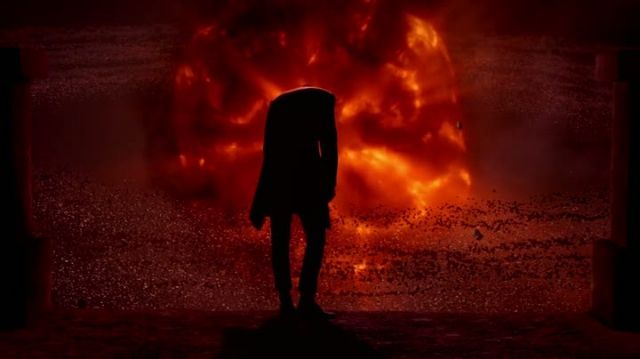
He becomes Headless. Like a Monk, perhaps. Or, given the Jack-O-Lantern imagery of Akhaten himself, the Headless Horseman. The Man of Science consumed by Faith.
It's the big showdown, and it's a veritable showcase in Alchemy.
Rest now my warrior
Don't leave
Wake up
And let the cloak of life
Cling to your bones
It begins with the Song, sung by the Queen of Years, who first implores The Warrior to rest, but not to leave. Instead, wake up, come back to life -- this is a reversal of polarity, and it gives the Doctor (a Mighty Warrior in his own right) the inspiration to delivery his own alchemy upon the Old God. His is the alchemy of metal and glass, the alchemy of a spaceman -- the alchemy of the Ring and the Mirror.
DOCTOR: You like to think you're a God. You're not a God.
There are many principles to the Mirror. It has the power to, yes, "reverse the polarity," and one of those types of reversals is based on negation. The Doctor negates the Godhood of the God.
DOCTOR: You're just a parasite, eaten out with jealousy and envy and longing for the lives of others. You feed on them...on the memory of love and loss, and birth and death, and joy and sorrow.
He points out that the constant need to eat leaves one eaten. This rather goes back to another symbol of the Circle in the Square, the Snake eating its tail inside a Glass Box. It's also an inversion, that the eater is eaten.
Then comes the pairs of opposites: Love and loss, birth and death, joy and sorrow. These are not negations of each other, but manifested polarities. They are kith and kin, two sides of the same coin. Love and loss are the two sides of relationship; birth and death the two sides of life; joy and sorrow, the two sides of emotion, the peaks and valleys of experience.
DOCTOR: So... come on then. Take mine. Take my memories.
Interestingly, the Doctor convinces the Queen of Years that, being a manifestation of creation, at one with it and at the same time utterly unique, need not sacrifice herself to the Old God. He goes to such lengths to save her, but then he ends up taking her place as the Sacrifice. He offers up his memories, so important to this incarnation of the Doctor. To him, Remembrance is divine.
But, and let's not forget, the Doctor has been preoccupied some time now with removing the memory of himself from the Universe. He's been erasing records. Oswin gave him a clean slate with the Daleks!
And this desire to step away from his own aggrandizement comes, ironically enough, from several "big speeches" he's made through invoking his own story: first in the Library, to save the people lost there; then upon the hospital rooftop in Leadworth, to chide the Atraxi; and then, to his great humiliation, at Stonehenge, when it's all one big fake-out to stick him in a Chair inside a Box from which he can "never" escape, the "perfect prison" that contains a Memory of the Universe.
DOCTOR: I walked away from the last great Time War. I marked the passing of the Time Lords. I saw the birth of the Universe, and I watched as Time ran out. Moment by moment, until nothing remained, no time, no space, just me.
The memories the Doctor offers are alchemical. Earlier, he said he will "never walk away," but he offers the memory of walking away. He offers the memory of the passing of the Time Lords, but he is a Time Lord. He's seen the beginning and the end, the Alpha and the Omega. This places the Doctor in the position of the gods, but also juxtaposes his Oneness with Nothingness.
DOCTOR: I walked in Universes where the laws of physics were devised by a madman.
I can't help but think of the Divergent Universe, spawned by the mad Time Lord Rassilon. The Divergent Universe is a Universe without Time -- that is, without the Arrow of Time. Rather, it existed in a state of perpetual revolution, of Eternal Return. A Ring. The Doctor might also be referring to the Anti-Universe devised by the mad Time Lord Omega.
The Doctor, of course, is the Madman with a Box. Again, unity is confirmed.
DOCTOR: I've watched universes freeze and creations burn.
A song of fire and ice.
DOCTOR: I have seen things you wouldn't believe, I have lost things you will never understand.
Seeing is believing. And again with the invocation of LOST.
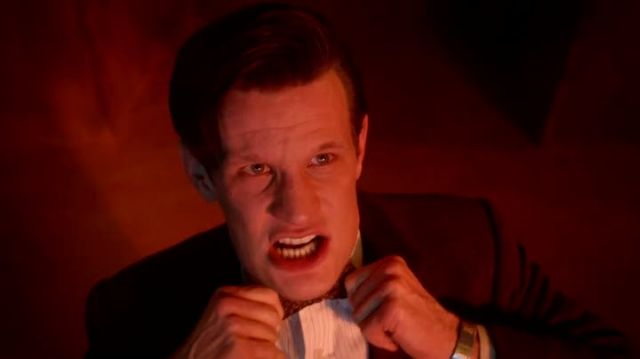

DOCTOR: And I know things, secrets that must never be told, knowledge that must never be spoken, knowledge that will make parasite gods blaze.
His name, of course, must never be told, never be spoken. A name so powerful it would set a false god on fire? And then he straightens his bowtie, as if he were fixing a marriage.
DOCTOR: So come on then! Take it, take it all, baby!
The snake eats its tail, returning to the moment of sacrifice, the moment the Doctor offers up his memories -- which are taken from his Hearts. "Come on, then!" he cries again, as he did at the beginning of the litany. The circle is complete -- and repeated, a line from The Eleventh Hour speech.
So, the Old God, the dying god, becoming as a baby in the face of the Lonely God who is the god of rebirth, of regeneration, of circles and rings, those Gallifreyen hieroglyphics spinning around the rotor of Time.
No wonder the Old God comes back.
The Song of Rebirth, and the Reborn God, cannot break the Rings of Akhaten. The Rings -- the symbol of Eternal Return, where there is no death.
What, oh what, could possibly defeat The Ring?
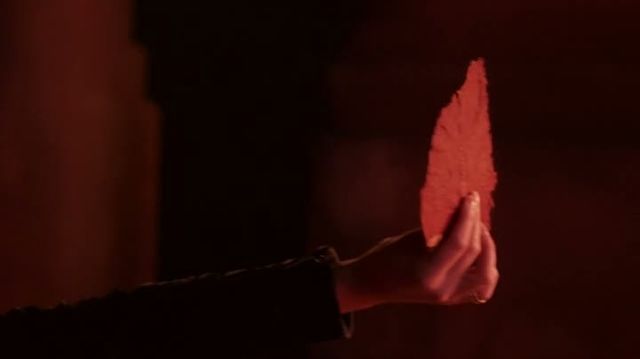
The World Tree is that which connects Above and Below and Past and Future into the Here and Now. It is the axis mundi which binds together the opposite ends of polarities. It is the line between birth and death, not the circle of eternity.
It can't be a circle, it just can't. Because in the circle, there is no escape. No death, but no birth. Just the Eternal Return of everything, unending, from which no other possibilities may spring.
Now we come round full circle to the end, to the climax of the story. The Doctor, who is the dying god perpetually reborn, gives his memories to the Sun God who desires the unending song, who feeds and feeds and demands sacrifice but never gives it up. The God of Circles who's ironically one-dimensional, going one way.
The Doctor's sacrifice can't defeat this sort of god. Because what the Doctor has to offer is simply a mirror of what this god already has. The Sun God is reborn -- perhaps that's why the Doctor's memories aren't lost, because to lose those memories would deny their power of rebirth.
So here comes Clara with her Leaf and--
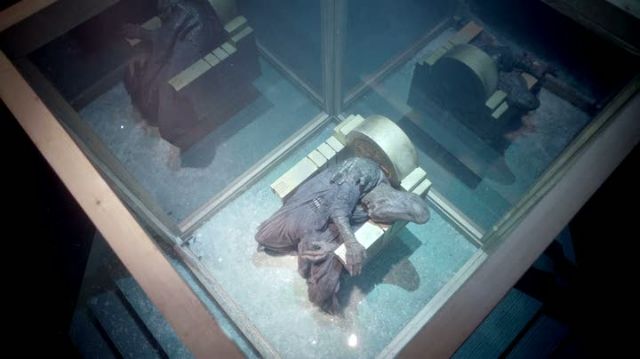
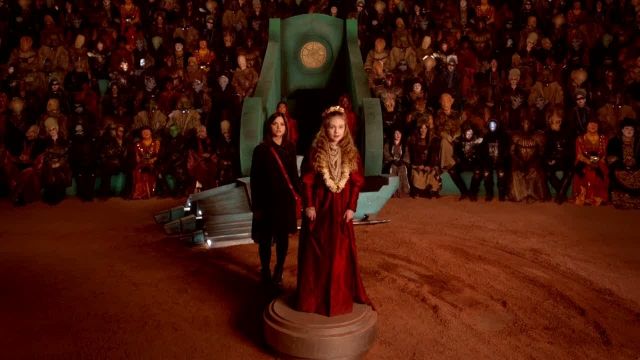
--and, well, let's just pause here for a second. Because in these two images there's a... similarity.
On the left, we see inside the Mirror Box... a Chair. The Chair, as discussed before, is also an Ascension symbol. At its best, it's the symbol of self-sacrifice. In the Library, in particular, that place of Books, it's a One-Way Ticket.
On the right, there's Clara's moped, in front of the Tunnel bearing the same motif as the chair in the tomb. The Tunnel itself is vaguely Chair-shaped. Clara gets on the moped -- it's a mobile chair -- to return to the Doctor, and she's carrying a Book. The Book which has a Leaf as Page One.

The sacrifice of The Leaf is different from the Doctor's sacrifice in several respects.
First, it's a symbol of what she gives. In an alchemical text, the symbol is synonymous with its referent, but it also acts as a shield, a layer of metaphor if you will. The tendrils of the Old God pierced the Doctor's hearts, going straight to the source. But by offering a Leaf, Clara's sacrifice isn't so literal -- because it's the meaning that matters, not the waste of an actual life.
And yet this Leaf is filled with contradictions, because it is representing an actual life. A singular, precise, exact life, lived in a singular, precise, and exact time and place, with a very definite end. This Leaf is a leaf of connection, of birth, but ultimately of Death. A single woman's death, never to be repeated in the whole of creation.
So what does such a singularity yield?
CLARA: The most important leaf in human history. It's full of stories, full of history, and full of a future that never got lived. Days that should have been that never were. Passed on to me. This leaf isn't just the past, it's a whole future that never happened. There are billions and millions of unlived days for every day we live. An infinity. All the days that never came.
So this is what Death gives us. It gives us that infinity of possibilities, all those days so unique, so very much ours and ours alone. It gives us an infinity that is so much bigger than the infinity of immortality. And so it's a contradiction, that the void of death has the power of creation right on the other side of it.
The Leaf is full of stories. The Doctor says, when clarifying to Clara, that "soul is made of stories, not atoms." Yet when he tells Merry a story, it's not a story of souls. It's the story of the Universe.
DOCTOR: All the elements in your body were forged many, many millions of years ago, in the heart of a far away star that exploded and died. That explosion scattered those elements across the desolations of deep space. After so, so many millions of years these elements came together to form new stars and new planets. And on and on it went. The elements came together and burst apart, forming shoes and ships and sealing wax and cabbages and kings. Until, eventually, they came together to make you. You are unique in the Universe. There is only one Merry Gelelh. And there will never be another.
Which is exactly the story of the Leaf. Not the story of the Ring.
However, there's another element to this Leaf that can't be forgotten. It's the token saved by Dave Oswald when he falls in Love with Ellie Ravenwood. This Leaf, shaped like a heart, but held upside-down, bright red -- now wee see why Clara's sacrifice succeeded where the Doctor's failed. Clara's Leaf -- the Token of the Tree of Life -- is imbued with the Alchemy of Love and Death -- the love of her parents, the death of her mother, the averted death of her father. It is, in fact, the Alchemy of the Wedding of River Song. It is the only alchemy that can defeat The Ring of Eternity.
Who Are You?
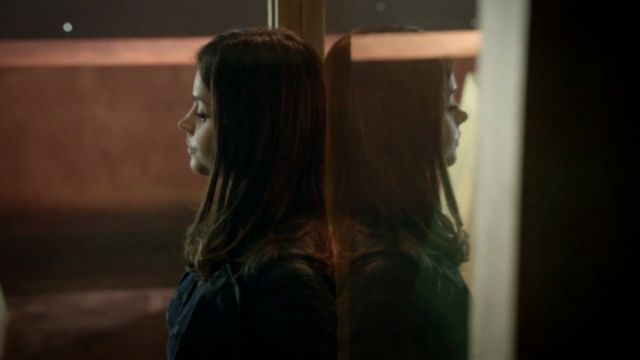
The Doctor has been on a Quest. He's held up the mirror of The Question and directed it towards Clara. The impossible woman who's died twice. He needs to know Who She Is.
Now, we've seen Clara juxtaposed with The Little Girl -- a recurring figure in Doctor Who mythology the last five or so years. The Little Girl is the Savior of All in The Library -- but also the Spoonhead who hoovers up souls in The Bells of Saint John. She is at once both divine and terrifying.
In order to present both sides of Clara, she needs someone else to be juxtaposed with, someone besides the Queen of Years, who is story and time, the color of Red, the bearer of Song and Faith, but who cannot be Sacrifice, cannot be Death. No, to Reveal the Other Side of Clara, we need to look to The Mirror, the object which holds the key to identity.
Above is the one of the few reflections in the entire story, and the only one of Clara. She is reflected in the Glass Box that holds the Mummy. (Clara, remember, has been juxtaposed with her Mum.)
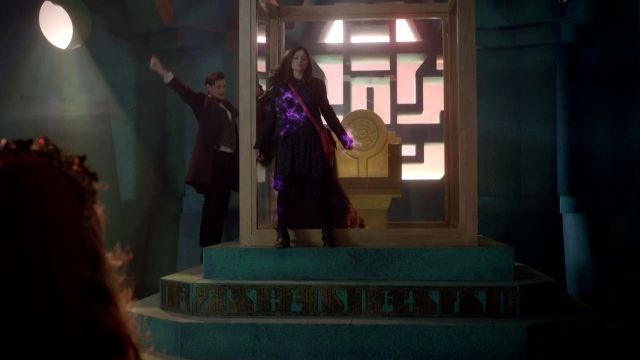
It's the Little Girl who, through the force of her mind, plasters Clara up against the Glass Box. The awakened Mummy paws at the glass, right behind Clara, as if it were her shadow. The Box, I must remind, holds the Chair of Sacrifice inside, which bears the symbol of the Circle. The hieroglyphs around the base of the dais resemble Keys. (Clara was offered a Key to the TARDIS, twice, but she doesn't have one now.)
This is a very symbolic, alchemical image.
Remember, the "Grandfather" in the Box turns out not to be "Grandfather" after all. He is not in juxtaposition with The Doctor. He's just "the alarm clock" that wakes the real Grandfather, who is the Old God juxtaposed with the Doctor.
Who is Clara? She's an Alarm Clock.
The Bells of Saint John are Ringing.
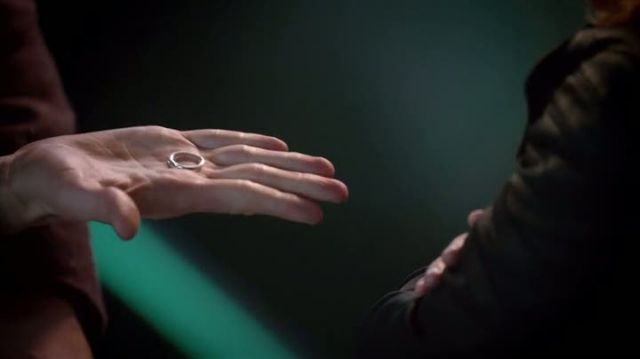
Laid out on the Doctor's hand is The Ring. This was Clara's first sacrifice, the sacrifice she made to get the Moped, which is just a Mobile Chair. She gave up The Ring so she could give up The Leaf. The people of Akhaten wanted to make sure she got The Ring back!
How alchemical is this? She receives the token representing the principle she defeated, defeated by the story of singularity, of the unique death that opens up an infinity of possibilities, using a symbol that's been infused with Love. But this ring, it's an engagement ring. Used for Weddings. And it's silver.
Clara is The Woman Who Died Twice. And still she lives.
So who's the truly Eldritch God?
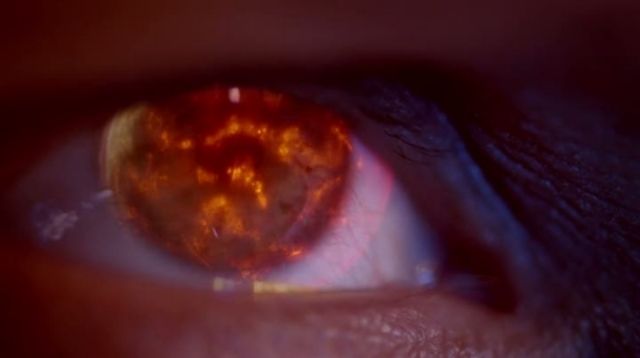
spoilers through the episode.
meta: Myth, Chairs, Mirrors, Rings vs. Leaves
Special Guest Star: Ouroboros
[Open Your Eyes]------------------------------------------------------------------------------



The opening shot. Leaves on the ground, all dead. The next shot has more dead leaves, and the third, blowing on the wind. Now, as a director, if you're devoting your first three shots to dead leaves, you better have a good reason. It's got to be important symbolically, thematically, something that will pay off in the climax of the story.
Here's the fourth shot:

A wood door. The strip of metal on the frame forms a visual ring. The door shuts, blocking out the light, effectively closing the loop. This is a metaphor, and it sums up the entire climax of the story. It's a story of a Tree defeating a Ring. Pretty clever, eh?
With that in mind, we can begin.
First, these are all images of death. Subtle, yes, but death isn't always grandiose, full of pomp and circumstance. Sometimes death comes as a whisper on the wind, a stillness in the heart, or a leaf in the face. Dave Oswald receives the latter, stumbles out into the street, and is about to die when he's saved by Ellie Ravenwood. Dave gets a new lease on life, and he makes the most of it.
He takes the singular leaf and from it he fashions a story of Love.
DAVE: This exact leaf
had to grow in that exact way, in that exact place,
so that precise wind could tear it from that precise branch
and make it fly into this exact face, at that exact moment,
and if just one of the tiny little things had never happened
I'd never have met you.


So, a bit on names. "Oswald" is often taken to mean "God's power." But another etymology lurks beneath the surface: "wald" means forest in German. David, on the other hand, comes from the Hebrew, "beloved." Also there's only one David in Christian bible, but he's referenced over a thousand times, most famously for slaying Goliath and becoming King of Israel.
Ellie, popularly thought to mean "light," derives from Eleanor, which has many variations -- including Leonora and Lenore, the latter most well known through Edgar Allen Poe's poems. "Lenore" is about the the death of a young woman, but rendered in uplifting verse:
"Avaunt! - to-night
My heart is light -
No dirge will I upraise,
But waft the angel on her flight
With a Pæan of old days!
Let no bell toll!
Lest her sweet soul,
Amid its hallow'd mirth,
Should catch the note
As it doth float
Up from the damned earth -
To friends above, from fiends below, th' indignant ghost is riven -
From grief and moan
To a gold throne
Beside the King of Heaven?"
But of course everyone's much more familiar with The Raven. Poe's raven comes tapping and rapping on the door, a messenger of mournful and never-ending Remembrance -- which is much in line with the Raven's mythological connotations, be it the bird spurned by Apollo for delivering news of unfaithfulness, or Odin's twin ravens of thought and memory.
Once upon a midnight dreary, while I pondered, weak and weary,
Over many a quaint and curious volume of forgotten lore -
While I nodded, nearly napping, suddenly there came a tapping,
As of some one gently rapping, rapping at my chamber door.
"'Tis some visiter," I muttered, "tapping at my chamber door -
Only this and nothing more."
Ah, distinctly I remember it was in the bleak December;
And each separate dying ember wrought its ghost upon the floor.
Eagerly I wished the morrow; - vainly I had sought to borrow
From my books surcease of sorrow - sorrow for the lost Lenore -
For the rare and radiant maiden whom the angels name Lenore -
Nameless here for evermore.
Funny how Ellie's last name is Ravenwood, drawing on the mythic bird implied by her name, set in the forest shared in common with the name of her betrothed.

When Ellie dies, and book of 101 Places to See falls to her daughter. And with it, the Leaf that brought all these events into being. It's not an ordinary leaf, by any means. This is an alchemical leaf. It is a Leaf that represents both Love and Death.
If that sounds familiar, it should. It's the main thrust of The Wedding of River Song.
In the Wedding, River doesn't want to kill the Doctor, and the Doctor doesn't want to marry River. She doesn't want to lose him, and he doesn't want to accede to love and the pain that inevitably comes of it. And yet to resolve the problem of all of time happening at once, both of them must give in. The Doctor must love, and the Doctor must die.
These two things happen in two different places, yet simultaneously. They occur at a Lake, and at a Pyramid (where Eldritch terrors are encased in Glass.) The funny thing is that when when the Doctor and Clara wake up the Grandfather God after defeating the mummy at the Pyramid of Akhaten, they discuss running away to "the Lake District."

Sorry, I'm getting ahead of myself.
The World Tree is that which connects Above and Below and Past and Future into the Here and Now. It is the axis mundi which binds together the opposite ends of polarities. It is the line between birth and death. It is not, importantly, a Ring.
Now, there are all kinds of trees in the world, all kinds of leaves. And strangely enough, the Leaf we see in The Rings is not quite the same as the Leaf we see in The Bells. It's like a Maple Leaf (which is sweetness, hello!) turns into a Linden Leaf. And the Linden Tree has an interesting presence in Myth and Literature.
It is a tea made from Linden Leaves that the narrator of Proust's In Search of Lost Time dips his petite madeleine, triggering the wash of Memory that is subsequently explored throughout that seminal work. Yes, "Lost Time."
Yesteryear's poems often equated the Linden Leaf with Love, because the leaf is shaped like a Heart. How perfect is it that Clara's Leaf just happens to be Red?
The ancient Germans held community festivals under a Linden Tree, but also judicial proceedings -- it was believed the tree could unearth the truth. The Greek myth of Baucis and Philemon has them blessed by the gods at their death, becoming an oak tree and linden tree, respectively, intertwined and overlooking an ornate temple in the middle of a lake -- a lake formed by a flood in punishment towards the otherwise inhospitable inhabitants; only Baucis and Philemon shared their wine and food with the disguised gods of Zeus and Hermes.
Of most interest to me is the story of Siegfried in the Nibelungenlied, the basis for Wagner's Ring Cycle. In this ancient myth, the crown prince of Xanten who slayed a dragon. By bathing in the blood of the dragon, Siegfried became completely invulnerable -- except for a single spot on his back, where a Linden Leaf had stuck.
With that in mind, let's turn to the other primary symbol in this episode:



This is a recurring motif in the current era. It is the conjunction of Square and Circle, and it is an alchemical referent. "Squaring the Circle" is a mathematical impossibility, but symbolically the Circle in the Square stands for the union of opposites, the basic principle of alchemy. Finding Eeternity in the Now. It's also a motif of Order, so geometrical, so... perfect.
All those heads in boxes, from A Good Man to Dorium's head in the Wedding, to the heads in boxes of The Great Intelligence's cloud, play on this motif. It's even punned -- inventing the QuadriCycle.
But the single best representation of it has to come from The Doctor's Wife:

The Snake (or Wurm, or Dragon) eating its own tail, encased in glass, the mark of the Corsair, who is a Pirate -- a parasite -- is the symbol of Ouroboros, an ancient symbol of the cycle of life. The symbol first appears in the historical record in Egypt, in the tomb of Tutankhamun. The New Adventures -- Doctor Who books from the early 90's -- played with the symbol in the Timewrym quartet. Plato describes the Ouroboros as the first living thing in the Universe.

The Snake is the Alpha and Omega, the beginning and the end, death and rebirth; it also symbolizes the One and the All -- affirming that the individual and the Universe are One. It is Communion. The alchemist Cleopatra of Egypt -- not to be confused with the eponymous queen -- drew the Ouroboros as a fusion of light and dark, of opposites.
Here's the thing about Ouroboros: Life feeds on Life. It is a symbol of Eating, of Consumption, for Eternity. And it's in this symbol that the "god" Akhaten feeds on the neverending Song given over and over again by the people of the Seven Worlds.
On the Nature of Being Lost

Another visual allusion to the alchemical principle of fusion -- the union of opposites -- in Doctor Who is the juxtaposition of Red and Blue. It's been with us since Rose (or Paradise Towers for you Classic fans.) We code Red and heat, passion, flame and fire, the sun, light; Blue is cool, water, ice, the moon, night.
Akhaten is already infused with Alchemy. It is a place beyond the confines of dualism. We see a Pyramid, a place of Death that's supposed to be a place of Rebirth, sitting upon an Island in space.
Yes, an Island.
But we don't see this principle just in places. It's very often coded in people and their possessions. Melody's Red Corvette skidding to a halt next to the Doctor's Blue Box. Rory's favorite car parked outside the blue door of Amy's new home. Especially in Moffat's era, it's a regular part of our Companion's outfits, like Amelia Pond sitting in the garden, waiting for the Doctor in her blue duffel coat and red wellies.


Clara continues this trend. She wears Red and Blue as a child, swinging between her parents. She matches a red purse with her blue dress. When she needs a place to hide a Little Girl wearing a red cloak, behind the blue box is just about perfect.
The Little Girl, by the way, is called The Queen of Years. She is a Child of Time. But she's also a Child of Story -- she knows every poem, every song, the entire history of her people.
It's behind the blue box -- which has that lovely St John Ambulance symbol on the front, another Circle in a Square -- that Clara shares the tale with Merry of how she got Lost. ("Lost" is a word repeated ten times in this story. I think it might be important.)
CLARA:
I used to be terrified of getting lost.
Used to have nightmares about it.
And then... I got lost.
Blackpool beach, bank holiday Monday.
About ten billion people;I was about six.
My worst nightmare come true.
Now, this is an interesting story, because it sounds... familiar. Very familiar to the story told by another little girl who got Lost. A little girl who wore Red Wellies. Ringing any bells?


JENNIFER:
When I was a little girl, I got lost on the moors.
Wandered off from the picnic.
I can still feel how sore my toes got
inside my Red Wellie boots.
And I imagined another little girl, just like me,
in Red Wellies, and she was Jennifer, too.
Except she was a strong Jennifer, a tough Jennifer.
She'd lead me home.
The Rebel Flesh took place on an Island where they mined Acid -- which, in addition to being an industrial solvent, is also a hallucinogenic drug that can change people's lives. By the end of this story, Jen becomes a Monster, and Amy Pond gets juxtaposed with her, Revealed as being of The Flesh, and is then melted by the Doctor, only to Wake Up in a small box, all white, like a coffin, ready to give birth to a Song. A horrifying vision of Ascension.
(Interestingly, the book referenced in last week's episode, Summer Falls by Amelia Williams, invokes some of the imagery from that story. A little girl, Kate Webster, gets caught in a "snow globe" that makes it such that her new little village is like an Island separated from the rest of the world. There's a Weather Vane that's part of the resolution to the story. Anyways, I digress, mostly to make the point that The Island in the TV show "LOST" is described as being "stuck in a bloody snowglobe," an image that recurs in Fringe, which features Red and Blue universes that may be crossed via... you guessed it, an Island. Ellis Island.)
Meanwhile, in Doctor Who, Clara is telling Mary a story:
MERRY:
What happened?
CLARA:
The world ended. My heart broke.
And then my Mum found me.
We had fish and chips
and she drove me home
and she tucked me up
and she told me a story.
So, a couple things here. First, how apocalyptic it is to be lost! The end of the world, and a broken heart... and then salvation. Mom comes, and there's a communion of fish and chips. Rose and the Doctor typically communed over Chips, while Eleven's food of communion is definitely Fish, preferrably dipped in custard.
Lots and lots of Fish in Moffat's work. It's also symbolic -- think the Icthys of Christendom. Communion, all I'm saying. Anyways, we now get a FlashBack to the story Clara's mum tells Clara, which presumably Clara then tells Merry:
ELLIE:
It doesn't matter where you are --
in the jungle or the desert or on the moon.
However lost you may feel,
you'll never really be lost. Not really.
Because I'll always be here.
And I'll always come and find you.
Every single time.
And this is rather important to the overall story, because now Clara's telling the Little Girl-Queen of Stories a story, in such a way that Clara is to Merry as Ellie is to Clara. There's a level of Mirroring going on here between the two, an establishment of juxtaposition that allows us to draw parallels between these two characters -- in particular, it gives us a metaphor for Clara, who is the great "unknown" in this long tale. It also establishes foreshadowing: Clara, as her mother, goes after the Little Girl... and Ellie, being Clara's mum, does indeed "find" Clara in the end.
Here's another way that Clara and Merry are juxtaposed:


The takes Clara's hand when they first get to Akhaten. Later, he takes Merry's hand. Now, this is a trope of the new series. Nine was always taking Rose's hand and leading her away from danger, a chance to go and run; so too with Ten and his companions, including River; so too with Eleven and Amy, upon their first meeting.
It's lampshaded in The Snowmen, when Clara takes the Doctor's hand and leads him away from the Ice Governess, reversing their roles as he protests.
The Doctor has made Merry like a "companion" by taking her hand, which makes her like Clara.
But that's not the only hand-taking that occurs in this episode. When Clara first meets Merry, and wins her trust by recognizing that the girl is distressed (or "lost") she takes her by the hand and leads her to the TARDIS. And the TARDIS won't let her in. Clara wonders if the TARDIS doesn't like her.
I'm not sure that's quite it. Look at this:


Clara is behaving "Doctorish" by taking Merry by the hand, but Clara's not ready to be Doctorish yet. Merry's the one who's full of stories and songs, and more importantly, she's will to make sacrifice: she's closer to divinity than Clara, a suggested by the iconography.
Or maybe it's that the TARDIS recognizes that it's not time to hide, but to connect, to share stories, to allay fear and exchange hugs. To be found.
Regardless, Clara and the Little Girl are mirrored. But she's not the only mirror for Clara:


So many recurring motifs! On the left is a shot of Clara just as she's getting involved with the Little Red Riding Hood. The shot is made from inside a large silvery tube -- silver is the color of Mirrors, of reflections -- and it's as if Clara is about ready to fall down The Rabbit Hole.
It's the first way that Alice in Wonderland "gets lost" -- the second time, she passes Through The Looking Glass.
It's a shot that's very similar to a shot from Closing Time. The Doctor crawls down a narrow tunnel to the Cybership -- a tunnel he finds behind a Mirror.
But the shot on the right has a second purpose, which is to juxtapose Clara. On the right, from the same angle, we see The Vigil. Thematically speaking, we should see Clara taking on the role of The Vigil somewhere in the story.

The Vigil: Interesting name for what amounts to a bunch of henchmen.
A "vigil" is ritual of wakefulnesss, of paying attention, staying alert, focused, concentrated. Liturgical vigils often incorporate periods of silence and meditation with chants, prayers, and readings. Some vigils can last all night, as did the vigils of medieval knights before their initiations.
If there's somebody up there could they throw me down a line
just a little guiding light to tell wrong from right
just some answers to the questions that I'm asking you
I'll keep a vigil in a wilderness of mirrors
where nothing here is ever what it seems
I'm scared to shout in case I draw attention from the powers
that preside over our minds and our lives
when they find what I want is the deadliest weapon,
that is truth
"Vigil (in a Wilderness of Mirrors)" -- Fish
In modern times we often use the Candlelight Vigil as a ritual of remembrance. Interestingly, the first Vigiles were ancient Romans charged with putting out fires -- professional firefighters. Because they patrolled at night as well as day, they became Watchmen, on the lookout for burglars and other criminals. So firefighters doubled down as Policeman. Huh.

In this story, The Vigil are charged with making sure the Queen of Years will take her place as sacrifice; they are a combination of "watchmen" and religious authority. Clara fulfills their function when she leads Merry back to the other Choristers, foreshadowed by the TARDIS (where Clara first leads Merry) being behind bars.
Police Box, indeed.
The Nature of Alchemy

Red Background + Blue Doctor = Purple Clothes
The other character juxtaposition of note has to do with the Doctor. The Doctor brings Clara to a place he's been before -- a place he's taken his Granddaughter. Now, fans of the Classic series will remember that when we first meet the Doctor, who in his first incarnation is a cantankerous old man, he's traveling with Susan, his granddaughter who always calls him "Grandfather" rather than "The Doctor."
The Doctor is the Mad Man in a Box. Guess who else we get "in a box" this episode? A "god" who is referred to as "Grandfather." Well, except that the mummy isn't Grandfather after all. No, that belongs to the "star/planet" around which the Rings spin. An Abomination that eats people's souls by eating their stories -- practically the opposite of the Doctor.
This is what happens to the Doctor in his confrontation with Akhaten:

He becomes Headless. Like a Monk, perhaps. Or, given the Jack-O-Lantern imagery of Akhaten himself, the Headless Horseman. The Man of Science consumed by Faith.
It's the big showdown, and it's a veritable showcase in Alchemy.
Rest now my warrior
Don't leave
Wake up
And let the cloak of life
Cling to your bones
It begins with the Song, sung by the Queen of Years, who first implores The Warrior to rest, but not to leave. Instead, wake up, come back to life -- this is a reversal of polarity, and it gives the Doctor (a Mighty Warrior in his own right) the inspiration to delivery his own alchemy upon the Old God. His is the alchemy of metal and glass, the alchemy of a spaceman -- the alchemy of the Ring and the Mirror.
DOCTOR: You like to think you're a God. You're not a God.
There are many principles to the Mirror. It has the power to, yes, "reverse the polarity," and one of those types of reversals is based on negation. The Doctor negates the Godhood of the God.
DOCTOR: You're just a parasite, eaten out with jealousy and envy and longing for the lives of others. You feed on them...on the memory of love and loss, and birth and death, and joy and sorrow.
He points out that the constant need to eat leaves one eaten. This rather goes back to another symbol of the Circle in the Square, the Snake eating its tail inside a Glass Box. It's also an inversion, that the eater is eaten.
Then comes the pairs of opposites: Love and loss, birth and death, joy and sorrow. These are not negations of each other, but manifested polarities. They are kith and kin, two sides of the same coin. Love and loss are the two sides of relationship; birth and death the two sides of life; joy and sorrow, the two sides of emotion, the peaks and valleys of experience.
DOCTOR: So... come on then. Take mine. Take my memories.
Interestingly, the Doctor convinces the Queen of Years that, being a manifestation of creation, at one with it and at the same time utterly unique, need not sacrifice herself to the Old God. He goes to such lengths to save her, but then he ends up taking her place as the Sacrifice. He offers up his memories, so important to this incarnation of the Doctor. To him, Remembrance is divine.
But, and let's not forget, the Doctor has been preoccupied some time now with removing the memory of himself from the Universe. He's been erasing records. Oswin gave him a clean slate with the Daleks!
And this desire to step away from his own aggrandizement comes, ironically enough, from several "big speeches" he's made through invoking his own story: first in the Library, to save the people lost there; then upon the hospital rooftop in Leadworth, to chide the Atraxi; and then, to his great humiliation, at Stonehenge, when it's all one big fake-out to stick him in a Chair inside a Box from which he can "never" escape, the "perfect prison" that contains a Memory of the Universe.
DOCTOR: I walked away from the last great Time War. I marked the passing of the Time Lords. I saw the birth of the Universe, and I watched as Time ran out. Moment by moment, until nothing remained, no time, no space, just me.
The memories the Doctor offers are alchemical. Earlier, he said he will "never walk away," but he offers the memory of walking away. He offers the memory of the passing of the Time Lords, but he is a Time Lord. He's seen the beginning and the end, the Alpha and the Omega. This places the Doctor in the position of the gods, but also juxtaposes his Oneness with Nothingness.
DOCTOR: I walked in Universes where the laws of physics were devised by a madman.
I can't help but think of the Divergent Universe, spawned by the mad Time Lord Rassilon. The Divergent Universe is a Universe without Time -- that is, without the Arrow of Time. Rather, it existed in a state of perpetual revolution, of Eternal Return. A Ring. The Doctor might also be referring to the Anti-Universe devised by the mad Time Lord Omega.
The Doctor, of course, is the Madman with a Box. Again, unity is confirmed.
DOCTOR: I've watched universes freeze and creations burn.
A song of fire and ice.
DOCTOR: I have seen things you wouldn't believe, I have lost things you will never understand.
Seeing is believing. And again with the invocation of LOST.


DOCTOR: And I know things, secrets that must never be told, knowledge that must never be spoken, knowledge that will make parasite gods blaze.
His name, of course, must never be told, never be spoken. A name so powerful it would set a false god on fire? And then he straightens his bowtie, as if he were fixing a marriage.
DOCTOR: So come on then! Take it, take it all, baby!
The snake eats its tail, returning to the moment of sacrifice, the moment the Doctor offers up his memories -- which are taken from his Hearts. "Come on, then!" he cries again, as he did at the beginning of the litany. The circle is complete -- and repeated, a line from The Eleventh Hour speech.
So, the Old God, the dying god, becoming as a baby in the face of the Lonely God who is the god of rebirth, of regeneration, of circles and rings, those Gallifreyen hieroglyphics spinning around the rotor of Time.
No wonder the Old God comes back.
The Song of Rebirth, and the Reborn God, cannot break the Rings of Akhaten. The Rings -- the symbol of Eternal Return, where there is no death.
What, oh what, could possibly defeat The Ring?

The World Tree is that which connects Above and Below and Past and Future into the Here and Now. It is the axis mundi which binds together the opposite ends of polarities. It is the line between birth and death, not the circle of eternity.
It can't be a circle, it just can't. Because in the circle, there is no escape. No death, but no birth. Just the Eternal Return of everything, unending, from which no other possibilities may spring.
Now we come round full circle to the end, to the climax of the story. The Doctor, who is the dying god perpetually reborn, gives his memories to the Sun God who desires the unending song, who feeds and feeds and demands sacrifice but never gives it up. The God of Circles who's ironically one-dimensional, going one way.
The Doctor's sacrifice can't defeat this sort of god. Because what the Doctor has to offer is simply a mirror of what this god already has. The Sun God is reborn -- perhaps that's why the Doctor's memories aren't lost, because to lose those memories would deny their power of rebirth.
So here comes Clara with her Leaf and--


--and, well, let's just pause here for a second. Because in these two images there's a... similarity.
On the left, we see inside the Mirror Box... a Chair. The Chair, as discussed before, is also an Ascension symbol. At its best, it's the symbol of self-sacrifice. In the Library, in particular, that place of Books, it's a One-Way Ticket.
On the right, there's Clara's moped, in front of the Tunnel bearing the same motif as the chair in the tomb. The Tunnel itself is vaguely Chair-shaped. Clara gets on the moped -- it's a mobile chair -- to return to the Doctor, and she's carrying a Book. The Book which has a Leaf as Page One.

The sacrifice of The Leaf is different from the Doctor's sacrifice in several respects.
First, it's a symbol of what she gives. In an alchemical text, the symbol is synonymous with its referent, but it also acts as a shield, a layer of metaphor if you will. The tendrils of the Old God pierced the Doctor's hearts, going straight to the source. But by offering a Leaf, Clara's sacrifice isn't so literal -- because it's the meaning that matters, not the waste of an actual life.
And yet this Leaf is filled with contradictions, because it is representing an actual life. A singular, precise, exact life, lived in a singular, precise, and exact time and place, with a very definite end. This Leaf is a leaf of connection, of birth, but ultimately of Death. A single woman's death, never to be repeated in the whole of creation.
So what does such a singularity yield?
CLARA: The most important leaf in human history. It's full of stories, full of history, and full of a future that never got lived. Days that should have been that never were. Passed on to me. This leaf isn't just the past, it's a whole future that never happened. There are billions and millions of unlived days for every day we live. An infinity. All the days that never came.
So this is what Death gives us. It gives us that infinity of possibilities, all those days so unique, so very much ours and ours alone. It gives us an infinity that is so much bigger than the infinity of immortality. And so it's a contradiction, that the void of death has the power of creation right on the other side of it.
The Leaf is full of stories. The Doctor says, when clarifying to Clara, that "soul is made of stories, not atoms." Yet when he tells Merry a story, it's not a story of souls. It's the story of the Universe.
DOCTOR: All the elements in your body were forged many, many millions of years ago, in the heart of a far away star that exploded and died. That explosion scattered those elements across the desolations of deep space. After so, so many millions of years these elements came together to form new stars and new planets. And on and on it went. The elements came together and burst apart, forming shoes and ships and sealing wax and cabbages and kings. Until, eventually, they came together to make you. You are unique in the Universe. There is only one Merry Gelelh. And there will never be another.
Which is exactly the story of the Leaf. Not the story of the Ring.
However, there's another element to this Leaf that can't be forgotten. It's the token saved by Dave Oswald when he falls in Love with Ellie Ravenwood. This Leaf, shaped like a heart, but held upside-down, bright red -- now wee see why Clara's sacrifice succeeded where the Doctor's failed. Clara's Leaf -- the Token of the Tree of Life -- is imbued with the Alchemy of Love and Death -- the love of her parents, the death of her mother, the averted death of her father. It is, in fact, the Alchemy of the Wedding of River Song. It is the only alchemy that can defeat The Ring of Eternity.
Who Are You?

The Doctor has been on a Quest. He's held up the mirror of The Question and directed it towards Clara. The impossible woman who's died twice. He needs to know Who She Is.
Now, we've seen Clara juxtaposed with The Little Girl -- a recurring figure in Doctor Who mythology the last five or so years. The Little Girl is the Savior of All in The Library -- but also the Spoonhead who hoovers up souls in The Bells of Saint John. She is at once both divine and terrifying.
In order to present both sides of Clara, she needs someone else to be juxtaposed with, someone besides the Queen of Years, who is story and time, the color of Red, the bearer of Song and Faith, but who cannot be Sacrifice, cannot be Death. No, to Reveal the Other Side of Clara, we need to look to The Mirror, the object which holds the key to identity.
Above is the one of the few reflections in the entire story, and the only one of Clara. She is reflected in the Glass Box that holds the Mummy. (Clara, remember, has been juxtaposed with her Mum.)

It's the Little Girl who, through the force of her mind, plasters Clara up against the Glass Box. The awakened Mummy paws at the glass, right behind Clara, as if it were her shadow. The Box, I must remind, holds the Chair of Sacrifice inside, which bears the symbol of the Circle. The hieroglyphs around the base of the dais resemble Keys. (Clara was offered a Key to the TARDIS, twice, but she doesn't have one now.)
This is a very symbolic, alchemical image.
Remember, the "Grandfather" in the Box turns out not to be "Grandfather" after all. He is not in juxtaposition with The Doctor. He's just "the alarm clock" that wakes the real Grandfather, who is the Old God juxtaposed with the Doctor.
Who is Clara? She's an Alarm Clock.
The Bells of Saint John are Ringing.

Laid out on the Doctor's hand is The Ring. This was Clara's first sacrifice, the sacrifice she made to get the Moped, which is just a Mobile Chair. She gave up The Ring so she could give up The Leaf. The people of Akhaten wanted to make sure she got The Ring back!
How alchemical is this? She receives the token representing the principle she defeated, defeated by the story of singularity, of the unique death that opens up an infinity of possibilities, using a symbol that's been infused with Love. But this ring, it's an engagement ring. Used for Weddings. And it's silver.
Clara is The Woman Who Died Twice. And still she lives.
So who's the truly Eldritch God?
